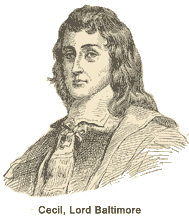Early Spanish mariners were probably the first white people to visit the Maryland area. The first European to record an entrance into Chesapeake Bay appears to have been Giovanni da Verrazzano in 1524.
It was not until the early years of the 17th century that English explorers arrived, Bartholomew Gilbert in 1603 and John Smith in 1608.
In 1631, the Virginian William Claiborne became the first European settler in Maryland when he opened a fur trading post on Kent Island in Chesapeake Bay.
In 1632, George Calvert, first Baron Baltimore and a recent convert to Roman Catholicism, obtained a charter from King Charles I that granted feudal rights in the land north of the Potomac River. The colony was to be named in honor of the king's consort, Henrietta Maria. Charles I was deeply concerned about the presence of the Dutch in North America and decided to establish Maryland as a buffer between Virginia and the New Netherland.
The exact boundaries were not accurately described, which led to a dispute with Virginia that would not be settled for 300 years. Before colonization began, the first Lord Baltimore died and left the grant to his son, Cecilius, the second Lord Baltimore.  Since the charter did not expressly prohibit the establishment of non-Protestant churches, Cecilius Calvert encouraged fellow Catholics to settle there.
While establishing a refuge for Catholics who were facing increasing persecution in Anglican England, the Calverts also were interested in creating profitable estates. To this end, and to avoid trouble with the British government, they also encouraged Protestant immigration.
Maryland's first town, St. Mary's, was established by both Protestants and Catholics in 1634. Arriving in the Ark and the Dove, they carefully chose a location high on a bluff near the point where the Potomac River flows into Chesapeake Bay.
The royal charter granted to the Calvert family embodied a mixture of feudal and modern elements. They were given the power to create manorial estates, but were limited to making laws only with the consent of the freemen (property holders). To attract and hold settlers, and to make the venture profitable, the family offered a limited form of land ownership. The number of independent farms grew and the farmers demanded a voice in the affairs of the colony. Maryland's first legislature, the House of Delegates, met in 1635.
The colony never experienced protracted Indian warfare or a "starving time" like its neighbor Virginia. Indeed, proximity to an established settlement allowed Maryland to trade for needed items. The colony also benefited from the largess of the proprietor, who personally supported the settlers' early financial needs. Like Virginia, Maryland suffered from a labor shortage and in 1640 introduced a headright system intended to stimulate immigration.
Protestants quickly outnumbered Catholics, a development that led to the passage of the Toleration Act in 1649. This interesting statement of religious toleration provided freedom of worship to all who believed in the divinity of Jesus, but decreed the death penalty for those denying the Trinity:
Since the charter did not expressly prohibit the establishment of non-Protestant churches, Cecilius Calvert encouraged fellow Catholics to settle there.
While establishing a refuge for Catholics who were facing increasing persecution in Anglican England, the Calverts also were interested in creating profitable estates. To this end, and to avoid trouble with the British government, they also encouraged Protestant immigration.
Maryland's first town, St. Mary's, was established by both Protestants and Catholics in 1634. Arriving in the Ark and the Dove, they carefully chose a location high on a bluff near the point where the Potomac River flows into Chesapeake Bay.
The royal charter granted to the Calvert family embodied a mixture of feudal and modern elements. They were given the power to create manorial estates, but were limited to making laws only with the consent of the freemen (property holders). To attract and hold settlers, and to make the venture profitable, the family offered a limited form of land ownership. The number of independent farms grew and the farmers demanded a voice in the affairs of the colony. Maryland's first legislature, the House of Delegates, met in 1635.
The colony never experienced protracted Indian warfare or a "starving time" like its neighbor Virginia. Indeed, proximity to an established settlement allowed Maryland to trade for needed items. The colony also benefited from the largess of the proprietor, who personally supported the settlers' early financial needs. Like Virginia, Maryland suffered from a labor shortage and in 1640 introduced a headright system intended to stimulate immigration.
Protestants quickly outnumbered Catholics, a development that led to the passage of the Toleration Act in 1649. This interesting statement of religious toleration provided freedom of worship to all who believed in the divinity of Jesus, but decreed the death penalty for those denying the Trinity:
That whatsoever person or persons within this Province and the Islands thereunto helonging shall from henceforth blaspheme God, that is Curse him, or deny our Saviour Jesus Christ to bee the sonne of God, or shall deny the holy Trinity the father sonne and holy Ghost, or the Godhead of any of the said Three persons of the Trinity or the Unity of the Godhead, or shall use or utter any reproachfull Speeches, words or language concerning the said Holy Trinity, or any of the said three persons thereof, shalbe punished with death and confiscation or forfeiture of all his or her lands and goods to the Lord Proprietary and his heires.The growing number of Protestants, especially Puritans, led to friction culminating in a brief civil war in 1655. For a number of years, William Claiborne, the original settler and frequent thorn in the Calvert family's side, ran the colony in defiance of the proprietors. Annapolis became the capital in 1694, supplanting St. Mary's. Baltimore was founded in 1730, Frederick in 1745, and Georgetown in 1751. The boundary between Maryland and Pennsylvania was settled according to the survey done by Mason and Dixon in 1763-67.